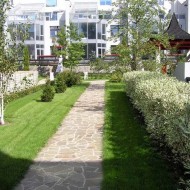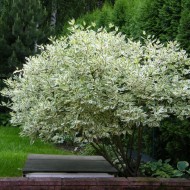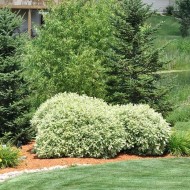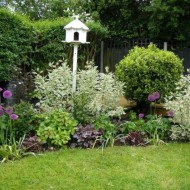How to Grow and Use Elegantissima White Derain in Garden Design
Content
Short description
Derain Elegantissima (Elegantissima) is a deciduous shrub belonging to the Cornelian family. It got its name for the elegant appearance of the crown and the variegated color of the foliage. This decorative form is most often used in landscape design of plots, gardens, urban landscaping, as it looks advantageous in any composition.
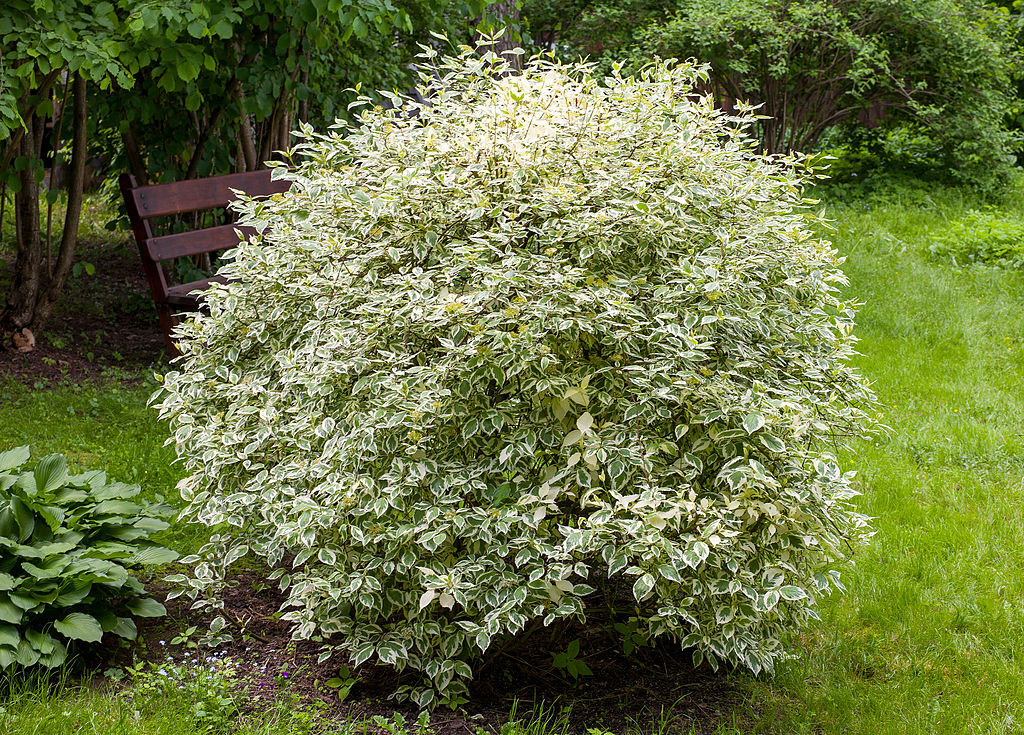
The plant has very thin and flexible shoots, intensively branching and stretching upward. Without regular pruning, it can reach a height of 3 m, growing in width by 4–5 m. The color of the shoots is brown, towards autumn it becomes rich red, so that the bush continues to decorate the garden even in winter. A feature of the variety is the large heart-shaped leaves of a grayish-green color with white or cream strokes and an openwork edging along the edge.
The first flowering of the shrub occurs at the age of three. In the future, it blooms twice a year - in early summer and in September, forming dense inflorescences, consisting of many small white flowers. After flowering, fruits are formed on the shoots - round berries with a diameter of about 8 mm. They ripen in time for September, when the bush blooms again, which gives it an additional decorative effect.
The fruits of the plant - small yellowish-white drupes - are inedible and not used for food.
Video "Cultivation of white Elegantissim turf"
This video tells about the features of planting and caring for an ornamental shrub.
Planting rules for ornamental shrubs
When properly planted, a shrub can grow in one place for up to 50 years, but for this you need to take into account the following requirements.
Optimal timing
Young bushes with an already formed root system are recommended to be planted in the fall, 1.5–2 months before the onset of constant cold weather. During this time, the plant will have time to take root and adapt to new conditions. Potted seedlings can be transplanted into the soil in the spring, but in this case they must be lowered into the hole along with an earthen clod, which will protect the roots from damage and speed up the rooting process.
Site and ground requirements
All types of turf take root well on any soil, except for clay and sandy loam. Loose fertile soil fertilized with organic matter is ideal. Planting is also possible on poor soils, but regular feeding will be required. A significant plus of the variety is immunity to groundwater, but this should not be abused. If you have to place the bush in the wrong place to create a composition, you should take care of drainage in advance.
Slight shading is even desirable for this variety, since its foliage may become too faded under direct rays. In the shade, on the contrary, the white edging on the leaf plates will become narrow and unobtrusive, due to which the plant will lose its decorative effect.

Seedling planting algorithm
A planting hole is dug in 2 weeks. It should be about 1.5 times wider than the seedling's earthen ball. Humus or compost is placed on the bottom, as well as mineral fertilizers. This composition will provide the plant with essential nutrients for the next few years. To make the soil compact, water is poured into the pit.
The landing algorithm is as follows:
- The seedling is watered and after 10-15 minutes it is removed from the pot along with a lump of earth. Plants with open roots are immersed in water for a couple of hours before planting.
- Carefully, supporting from below, the seedling is transferred to the planting pit, and set in the center so that after planting the root collar is not below the soil surface.
- Next, the bush is covered with earth, periodically tamping it.
- Seal the trunk circle and water abundantly.
For an autumn planting, nothing else needs to be done. If this happens in spring, then the near-stem zone is mulched so that the soil does not dry out, and the seedling is shaded from the sun for the first 3-4 days.
Features and secrets of growing white turf
Shrubs of white deren are unpretentious and do not require any special care. To maintain the decorativeness of plants, it is enough to perform just a few activities.
Watering and feeding
Only recently planted shrubs need regular watering. Adult bushes have enough moisture from precipitation and melting snow, but in abnormally hot weather they also need to be watered at the rate of 2 buckets per 1 plant. Watering is done in the evening or early in the morning, which allows you to protect the leaves from burns.
The first top dressing is applied after 3 years. Until this time, the plant consumes fertilizers laid down during planting. Bushes are fed infrequently, about once every 2-3 years, and even then - in case of illness or weakness. You can fertilize with both mineral mixtures and humus, humus or compost. You don't need a lot of organic matter - just add 100 g for each bush.
Pruning and shaping the crown
The shrub grows about 50-60 cm a year, so it needs to be cut and cut several times a season. This can be done at any time interval, except for the period when there is an active movement of juices. The first pruning of the bush is carried out 3 years after planting. It involves the removal of all damaged branches, as well as the removal of ⅓ part of the crown in order to further form it.

The scheme for subsequent pruning depends on what shape you want to give the shrub. Broken and protruding shoots are usually clipped regularly. The bush is cut more thoroughly in the fall, thinning it and removing 3-4 leading shoots. This procedure promotes abundant flowering.
Once every 3-4 years, all shoots are cut to a height of 15-20 cm in order to rejuvenate the bush.
Preparing for winter
Despite the fact that the roots of the white turf are superficial, it is on the list of the most winter-hardy plants. Even in the northern regions, shrubs can winter without shelter, as they normally tolerate severe frosts, and in case of freezing they quickly recover. The only exceptions are young seedlings planted in autumn. In harsh climates, it is better to cover them in the first winter.
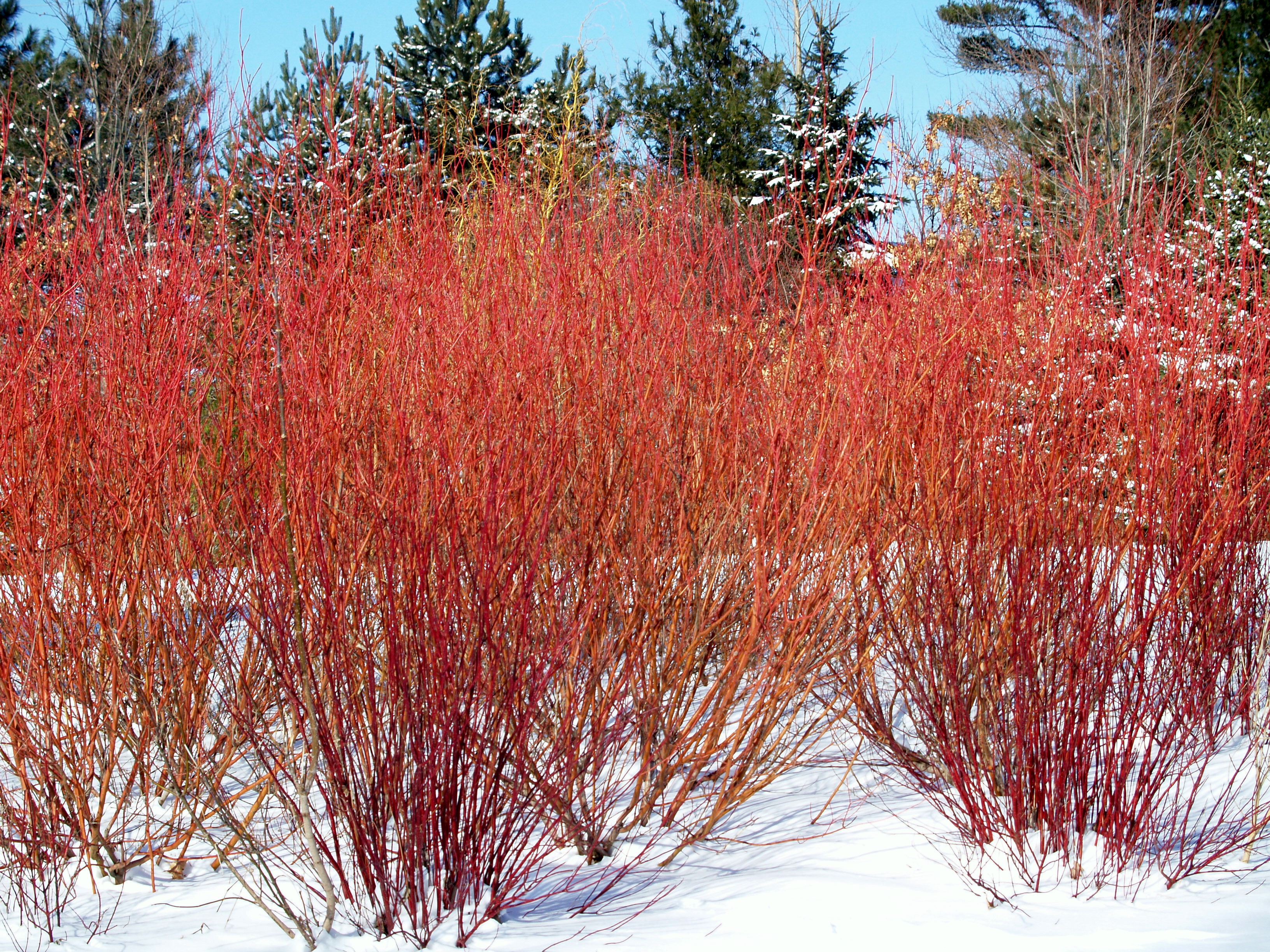
Reproduction of the white elegantissim deren
The ornamental shrub reproduces well in three ways.
Seeds
Seed propagation is a lengthy process. For sowing, fresh material collected in the fall is used. The seeds are stratified - they are kept in the cold for a couple of months, after which they are planted in the substrate to a depth of 3-5 cm.Sowing is done in a greenhouse in spring, but you can also sow directly into the ground before winter, then stratification is not needed - nature will do everything by itself. Seeds germinate for a very long time, 2-3 years, and it takes up to 8 years to grow an adult bush.
Layers
The plant reproduces best by root layers. To do this, in the summer, you need to bend the lowest young shoot to the ground, fix it, sprinkle it with earth and water it from time to time. By the fall, a root system will form on this layer, after which it can be separated with a pruner and transplanted to a new place.

Cuttings
The material is harvested at the beginning of summer from slightly stiff, but still flexible shoots, or those left over from spring pruning. Cuttings are planted in a humidified substrate at an angle of 45 °, the container is transferred to a greenhouse, where high humidity and air temperature are maintained at 25-30 ° C. By the fall, the cuttings develop roots, after which they are transplanted into pots and kept in the basement until spring planting.
Use in landscape design
Due to their flexibility and ability to tolerate pruning, white turf shrubs are very widely used in the design of backyards:
- they make beautiful "living" arches and dense hedges of different heights, which can be used to divide the space into zones or hide an unsightly building;
- with the help of a haircut, they are easily transformed into decorative garden elements: a ball, a cube, a hemisphere and other figures;
- in a group composition, they stand out in contrast due to light foliage;
- several trimmed plants look harmonious at the front of the house;
- low plants can be used to frame garden paths;
- a group composition of several shrubs, planted in the form of an island, looks elegant;
- the bush can be planted in the middle of the lawn, where it will create a vivid contrast to the emerald grass.
The variegated shrub looks most profitable in composition and against a background with openwork ornamental plants, for example, conifers.
In short, the Elegantissima variety is a versatile crop that can decorate any territory, both in summer and winter. Despite its elegant and rather fragile appearance, it is a very hardy plant that can grow and decorate a garden in almost any region.

